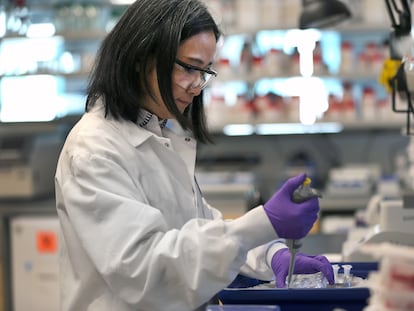Discovery of the mechanism behind asthma may help find an effective treatment for it
A team of scientists describes the cell death that occurs in the respiratory tract and explains the symptoms of the disease

The word asthma comes from Greek, and one of the first references in literature alluded to the shortness of breath that the heroes of the Iliad suffered after fighting. A few millennia later, the cause of asthma attacks — a sudden closure of the airways that can be fatal — is far from clear.
A study published on Thursday in the journal Science has just revealed a new cause of asthma attacks and suggests a path towards new treatments that could not only alleviate the symptoms, but also prevent the serious damage they can cause to the health of the people who suffer from it.
Until now, it was thought that asthma was a disease of the immune system against an internal, genetic or external agents, such as pollen or pollution. This immune reaction produced suffocation, inflammation of the respiratory tract, mucus, cough and the rest of the symptoms that characterize the disease. Current treatments are based on this idea and are aimed at opening inflamed airways with inhalers that dilate the bronchi, but do not attack the underlying cause of the disease.
The new work, led by researchers in the United Kingdom and the United States, explores the sudden contraction of the airways, especially their branches within the lungs, the bronchi. The team has analyzed this compression at the cellular level in the lungs of mice suffering from asthma and in respiratory tissue of patients. The results describe a phenomenon known as extrusion, which appears to be to blame for all of asthma’s subsequent airway effects. “Bronchoconstriction results in pathological overcrowding of cells in the airway epithelium, squeezing out (extruding) epithelial cells and thus damaging the epithelial layer enough to trigger inflammation,” says the study.
Elena Ortiz-Zapater, a researcher at the biochemistry department of the University of Valencia in Spain, developed the animal models for the study. “We have seen that after the constriction caused by asthma, the airways become very small very quickly, which affects the epithelial cells that line the inside of these airways,” explains the scientist. “We are talking about a type of cells that are not as flexible as muscle cells and that are not prepared for such an attack. As a result of the compression, the epithelial cells run out of space and end up dying and disappearing,” she adds.
After the attack, the airways remain “exposed” and allow pollutants or allergic agents to penetrate the body, which explains why asthmatics are more prone to suffer respiratory infections and how the vicious cycle of inflammation, obstruction and shortness of breath that characterizes asthma attacks.
Treatment for the causes
“Our discovery is the culmination of more than ten years work,” notes Jody Rosenblatt, cell biologist at King’s College London (United Kingdom) and lead author of the work, in a statement provided by the institution. “As cell biologists who watch processes, we could see that the physical constriction of an asthma attack causes widespread destruction of the airway barrier. Without this barrier, asthma sufferers are far more likely to get long-term inflammation, wound healing, and infections that cause more attacks. By understanding this fundamental mechanism, we are now in a better position to prevent all these events.”
The study also tested an experimental treatment that could be the first to attack the causes of asthma and not just relieve its symptoms. Researchers have shown how to prevent the widespread destruction of the cellular barrier of the airways using gadolinium, a compound used as a contrast in MRIs. Researchers have shown that this compound prevents the extrusion of epithelial cells after an airway contraction event, which in turn prevents the inflammatory response, mucus and other symptoms associated with asthma attacks.
Current treatments do not prevent cell destruction. “An inhaler such as Albuterol opens the airways, which is critical to breathing but, dishearteningly, we found it does not prevent the damage and the symptoms that follow an attack. Fortunately, we found that we can use an inexpensive compound, gadolinium which is frequently used for MRI imaging, to stop the airway damage in mice models as well as the ensuing inflammation and mucus secretion. Preventing this damage could then prevent the build-up of musculature that cause future attacks,” adds the statement.
It would have to be done, Ortiz-Zapater points out, by looking for a compound that imitates the activity of gadolinium, since this element can be toxic if administered too frequently.
This finding could stop the inflammatory cycle and even revolutionize current treatments for asthma, say Jeffrey Drazen and Jeffrey Fredberg, environmental health experts at Harvard University, in a commentary on the study also published in Science. The same mechanism, they point out, could be relevant to understanding and treating other diseases such as irritable bowel syndrome, also characterized by damage to epithelial cells due to sudden constrictions similar to those caused by asthma in the airways.
“The epithelial layer of the airways provides a first line of defense against foreign antigens and is essential for maintaining tissue homeostasis,” explains José Gregorio Soto Campos, director of the Pulmonology and Allergy Clinical Management Unit at the Hospital de Jerez in southern Spain, in statements to Science Media Center Spain. “It has previously been proposed that this loss of epithelial integrity that compromises the barrier function in asthma would not be secondary, but rather a cause of the pathogenesis of the disease, having important implications for the development of asthma.”
It remains to be elucidated why this sudden compression of the airways typical of asthma occurs. It is likely, Ortiz-Zapater points out, that it is due to several factors. The mystery of the original cause of the disease that the Greeks described continues.
Sign up for our weekly newsletter to get more English-language news coverage from EL PAÍS USA Edition
Tu suscripción se está usando en otro dispositivo
¿Quieres añadir otro usuario a tu suscripción?
Si continúas leyendo en este dispositivo, no se podrá leer en el otro.
FlechaTu suscripción se está usando en otro dispositivo y solo puedes acceder a EL PAÍS desde un dispositivo a la vez.
Si quieres compartir tu cuenta, cambia tu suscripción a la modalidad Premium, así podrás añadir otro usuario. Cada uno accederá con su propia cuenta de email, lo que os permitirá personalizar vuestra experiencia en EL PAÍS.
¿Tienes una suscripción de empresa? Accede aquí para contratar más cuentas.
En el caso de no saber quién está usando tu cuenta, te recomendamos cambiar tu contraseña aquí.
Si decides continuar compartiendo tu cuenta, este mensaje se mostrará en tu dispositivo y en el de la otra persona que está usando tu cuenta de forma indefinida, afectando a tu experiencia de lectura. Puedes consultar aquí los términos y condiciones de la suscripción digital.
More information
Archived In
Últimas noticias
More than 40 Democratic lawmakers urge Trump in a letter to stop his ‘attempts to undermine democracy in Brazil’
The journal ‘Science’ criticizes Trump’s anti-renewable energy policy: ‘The US is failing to benefit from its own innovations’
Cubans hope for a miracle as dengue and chikungunya spread
The long shadow of the father figure in the films of Rob Reiner
Most viewed
- Christian Louboutin: ‘Young people don’t want to be like their parents. And if their parents wear sneakers, they’re going to look for something else’
- Cartels in Mexico take a leap forward with narco-drones: ‘It is criminal groups that are leading the innovation race’
- ‘El Limones’ and the growing union disguise of Mexican organized crime
- Liset Menéndez de la Prida, neuroscientist: ‘It’s not normal to constantly seek pleasure; it’s important to be bored, to be calm’
- The low-cost creative revolution: How technology is making art accessible to everyone











































